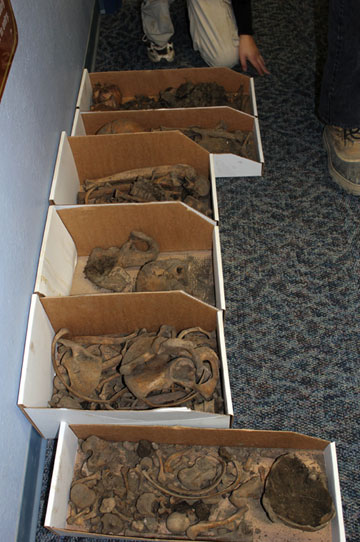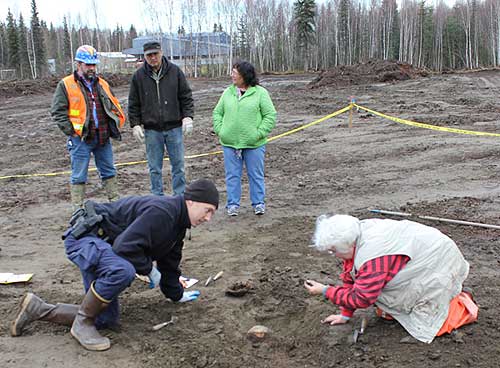
Ancient skeletons of McGrath raise questionsBy NED ROZELL
November 20, 2012
The discovery, recently announced in the Morris Thompson Cultural and Visitors Center in Fairbanks, is unique because bones often don’t last long when buried in the acidic soil of the boreal forest, and because the Native Athabaskans of the region have traditionally cremated their dead. “This in an archaeologist’s dream,” said Vicke Otte of MTNT, Limited, the local village corporation and the owner of the land in McGrath that held the remains. “They’ve hit the jackpot.” In October 2012, a worker on an erosion-control, ground-clearing project was walking over the site in his off-duty time and saw a human skull. He told his boss and the stripping of soil from the site stopped. Some locals thought the skull was probably from a female Native elder who had disappeared 30 years earlier. But when an archaeologist came to the site with an Alaska State Trooper, they unearthed three skeletons huddled together in the sandy soil along with two stone artifacts and no modern clothing. Archaeologists found an ancient fireplace above the skeletons. They dated the charcoal to after the time Columbus reached the new world, meaning the three people beneath were alive long before that. “They could be centuries older, it could be a millennium,” said Bob Sattler, an archaeologist for the Tanana Chiefs Conference. He and Tom Gillispie, another archaeologist for Tanana Chiefs, said the human bones “very likely” had preserved DNA in them, and they would use small bone samples to get more information on the mystery trio that were entombed together. They hope to get more funding to further explore the sandy site next summer. In addition to the skeletons, the ancient sand bar also features a deeper hearth site that holds charcoal and burned animal bones. A bulldozer operator exposed the fireplace under Gillispie’s watch. “My heart stopped when that appeared,” he said. The hearths and bones are within the modern boundaries of a community that started as a trading post in 1907. The current McGrath townsite is at the junction of the Kuskokwim and Tokotna rivers, one of the last spots upriver on the 700-mile Kuskokwim where salmon return in large numbers. Before U.S. Deputy Marshall Peter McGrath set up a headquarters there, people for centuries probably came there to fish, said area resident Ray Collins, a local historian who traveled to Fairbanks for the press conference. Trails around the area were well established at the time McGrath became a permanent settlement, he said.
Alaska State Trooper Jack LeBlanc and forensic archaeologist Joan Dale, both on their knees, unearth part of a human skull in McGrath. Standing in the background, with the McGrath School behind them, are, from left, Brant Dallas, Lucky Egress and Betty Magnuson.
At this point, there are more questions than answers. But with the agreement of local and regional Native corporations, the silent trio of McGrath may have plenty to say about ancient people in the area and beyond. “It has a bearing on the genetics of all the peoples of the New World,” Gillispie said. Collins credited the locals and Native leaders for agreeing to let scientists take a closer look at the bones with modern techniques. “They are giving some of their great-great grandparents an opportunity to speak once more,” he said.
Since the late 1970s, the University of Alaska Fairbanks’ Geophysical Institute has provided this column free in cooperation with the UAF research community.
E-mail your news &
photos to editor@sitnews.us
|
|||

